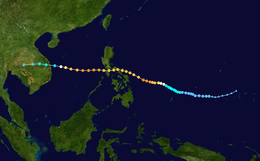Typhoon Trix (1952)
Typhoon Trix was a typhoon struck the Philippines as a Category 3 typhoon in 1952. It struck the Bicol region, floods and landslides unleashed by it killing 995 people.[1][2][3][4]
| Rank | Storm | Season | Fatalities | Ref. |
|---|---|---|---|---|
| 1 | "Haiphong" | 1881 | 20,000 | [5] |
| 2 | Haiyan (Yolanda) | 2013 | 6,300 | [6] |
| 3 | Thelma (Uring) | 1991 | 5,101–8,000 | [7] |
| 4 | Bopha (Pablo) | 2012 | 1,901 | [7] |
| 5 | "Angela" | 1867 | 1,800 | [8] |
| 6 | Winnie | 2004 | 1,593 | [8] |
| 7 | "October 1897" | 1897 | 1,500 | [8][9] |
| 8 | Ike (Nitang) | 1984 | 1,363 | [7] |
| 9 | Washi (Sendong) | 2011 | 1,268 | [7][10] |
| 10 | Trix | 1952 | 995 | [7] |
| Category 4 typhoon (SSHWS) | |
 | |
| Formed | October 15, 1952 |
|---|---|
| Dissipated | October 26, 1952 |
| Highest winds | 1-minute sustained: 220 km/h (140 mph) |
| Lowest pressure | 965 hPa (mbar); 28.5 inHg |
| Fatalities | 995 death |
| Areas affected | Philippines |
| Part of the 1952 Pacific typhoon season | |
References
- "::..Typhoon2000.com: 30 Worst Typhoons of the Philippines (1947-2002)..::". Archived from the original on 2009-03-17. Retrieved 2015-06-09.
- "Philippines' ten deadliest storms". 2014-12-07. Cite journal requires
|journal=(help) - "Typhoon tears down homes in disaster-weary Philippines". terradaily.com. Retrieved 2020-08-08.
- "The 10 deadliest typhoons in the Philippines". The National. Retrieved 2020-08-08.
- Philippine Storm Surge History. Project NOAH, University of the Philippines. 23 November 2013. Archived from the original on 8 November 2014. Retrieved 29 November 2013.
- del Rosario, Eduardo D. (April 2014). FINAL REPORT Effects of Typhoon YOLANDA (HAIYAN) (pdf) (Report). NDRRMC. Retrieved 21 April 2014.
- Alojado, Dominic (2015). Worst typhoons of the philippines (1947-2014) (pdf) (Report). Weather Philippines. Retrieved 25 September 2015.
- "10 Worst Typhoons that Went Down in Philippine History". M2Comms. 3 August 2016. Retrieved 3 August 2016.
- Lotilla, Raphael (20 November 2013). "Flashback: 1897, Leyte and a strong typhoon". Rappler. Retrieved 10 July 2014.
- Ramos, Benito T. (10 February 2014). Final Report on the Effects and Emergency Management re Tropical Storm SENDONG (WASHI) (pdf) (Report). NDRRMC. Retrieved 10 February 2014.
This article is issued from Wikipedia. The text is licensed under Creative Commons - Attribution - Sharealike. Additional terms may apply for the media files.